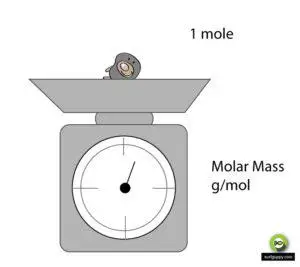Molar Mass Formula
The molar mass of a compound is simply the mass of the number of molecules of the compound. Between 1971 and 2019, SI defined the “amount of substance” as a separate dimension of measurement, and therefore the mole was defined because of the amount of substance that has as many constituent particles as the number of atoms. Since 2019, a mole of any substance is the amount of that substance containing an exactly defined number of particles, N = 6.02214076×1023. In this chapter, we will learn more about molar mass formula, calculation of molar mass and various examples.
Molar Mass Formula
The molar mass of a compound is the mass of a given substance divided by the quantity of substance therein sample. It’s bulk, not molecular, the property of a substance. The molar mass is a mean of the many instances of the compound, which frequently vary in mass because of the presence of isotopes. most typically, computation of molar mass is from the quality atomic weights and is thus a terrestrial average and a function of the relative abundance of the isotopes of the constituent atoms on earth.
Molar Mass= Mass of given substance/amount of substance
The molar mass is an intensive property of the substance, that doesn’t depend upon the dimensions of the sample. within the Systeme International d’Unites of Units (SI), the bottom unit of molar mass is kg/mol. However, for historical reasons, molar masses are nearly always expressed in g/mol.

Source: surfguppy.com
Calculation of Molar Mass
The molar mass of a compound is often calculated by adding the quality atomic masses (in g/mol) of the constituent atoms. For instance, the mass of titanium is 47.88 amu or 47.88 g/mol. In 47.88 grams of titanium, there’s one mole or 6.022 x 1023 titanium atoms.
The characteristic molar mass of a component is just the mass in g/mol. However, molar mass also can be calculated by multiplying the mass in amu by the molar mass constant (1 g/mol). To calculate the molar mass of a compound with multiple atoms, sum all the mass of the constituent atoms.
For example, the calculation of the molar mass of NaCl is for locating the mass of sodium (22.99 g/mol). And, therefore, the mass of chlorine (35.45 g/mol) and mixing them. The molar mass of NaCl is 58.44 g/mol.
Solved Examples for Molar Mass Formula
Q] Find molar mass of hydrogen (H2), sulfur (S8), chlorine (Cl2). Use Molar Mass Formula.
Solution: The molar mass of molecules of those elements is equal to the molar mass of the atoms multiplied by the number of atoms in each molecule.
Therefore, Molar Mass of (H2) = 2 × 1.007 97(7) × 1.000000 g/mol = 2.01588(14) g/mol
Molar Mass (S8) = 8 × 32.065(5) × 1.000000 g/mol = 256.52(4) g/mol
Molar Mass (Cl2) = 2 × 35.453(2) × 1.000000 g/mol = 70.906(4) g/mol.
Q] Find the molar mass of NaCl and C12H22O11.
Solution – For normal samples from the earth with typical isotope composition, the quality mass |mass”> relative atomic mass or the standard relative atomic mass is beneficial for the approximation of the relative atomic mass of the sample.
Molar Mass (NaCl) = [22.98976928(2) + 35.453(2)] × 1.000000 g/mol = 58.443(2) g/mol
Molar Mass (C12H22O11) = ([12 × 12.0107(8)] + [22 × 1.00794(7)] + [11 × 15.9994(3)]) × 1.000000 g/mol = 342.297(14) g/mol.